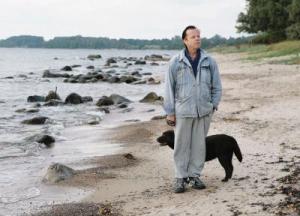Wallander’s beach
August 4, 2014 § 3 Comments
Can you imagine a community? The title of Benedict Anderson’s influential book, Imagined communities, suggests so. For Anderson, a nation is ‘an imagined political community – and imagined as both inherently limited and sovereign’. A community, in other words, that is not dependent on regular face-to-face interaction, on physical gatherings of people. Is it really possible, though, to imagine, to picture such a thing? And does it matter if we can’t? The ‘online community’ of users of social media has become a commonplace in our language. Yet I’ve started wondering if the communities established over Facebook or Twitter really serve the same function as their ancestors, which had physical centres in the forum, or the church, or the pub.
I suppose the suspicion I am harbouring is that virtual face-to-face interaction (an encounter that you can simply switch off) doesn’t provide the same exposure to other people, to the annoying fact of their existence, as its real-life equivalent. I’m thinking here along lines drawn by the French philosopher Emmanuel Levinas, who ascribes a particular ethical force to the face of the other (though his conception of the face is rather complex, stretching beyond the visible). In our digitised age, we can manipulate our Facebook news feeds to remove unwanted faces and presences, unfollow people we no longer like on Twitter.
At this point I should declare my particular position: I am writing this from a place which can be seen as a remnant of the sorts of ‘old-fashioned’ communities I mentioned above: a Cambridge college (St John’s). So perhaps that is skewing my viewpoint somewhat. There is certainly a danger of drifting into nostalgia here. The human impulse to look wistfully back on an imaginary whole is well known, and communities that appear perfect and homogenous were (are) frequently founded on exclusion. At St John’s we were reminded of this in a sermon given by Teresa Morgan at the annual Commemoration of Benefactors service in May. Professor Morgan insisted that we remember, along with the members of the college who died in the First World War, those people who because of their social background, or gender, could not even dream of being a member of the college.
I am certainly not advocating a return to the intensely stratified society of the 1910s, or earlier. But I will admit that I am glad to be able to belong to an easily identifiable body of people. I worry that when our belonging becomes ever more mediated by various forms of technology, it also becomes more superficial. The powers of empathy involved are diluted. When, for example, you can add your name to a political petition at the click of a button, are you really joining a community? To what extent are you really involved? And what are you involved in? Is it possible to picture it? These questions seem important to me. Then again, perhaps my longing for bodily participation and belonging ignores the fact that we are all now cyborgs (in Donna Haraway’s terms), beings for whom there is no clear dividing line between body and machine. Nonetheless, I am doubtful of the efficacy of our technological prostheses, however advanced they may be (Facebook’s acquisition of Oculus virtual reality technology was widely reported).
Strange as it may seem, I recently found an elegant example of a nostalgic desire for unproblematic, whole communities, and hint of their impossibility, in the the Swedish detective drama Wallander. In the final series of this drama, which is based on Henning Mankell’s novels, Kurt Wallander’s life slowly and inevitably falls apart as he comes to terms with the fact he has Alzheimer’s disease. This is interesting from our perspective as Wallander is often presented as taking the side of those excluded from full participation in society, such as a young offender released from prison, or an Eastern European prostitute. Yet his efforts to remedy their situations are thwarted, more often than not. Though some critics therefore see Mankell’s work as longing for an impossible wholeness, it seems to me that Wallander’s failures, and his Alzheimer’s, are a tacit recognition on the part of his creator that such unity is always imaginary, even when it relates just to one person.
What I mean by this is that we are never entirely ‘at one’ with ourselves. The image that we present to others (and to ourselves) of who we are can never be definitive, and at times we are so different from day to day that it is a struggle to claim our actions as really ours. Social media exaggerate this process, creating stark divides between our online selves and the ones we inhabit. The stubbornly liminal existence of both community and self in Mankell’s world is apparent in the TV series through a recurrent visual motif: that of Wallander wandering along a beach, gazing out to sea. The implication might be that we always feel, to some extent, that we are poised on the brink of nothingness, that our communities or selves are on the edge of disintegration, or already fragmenting. Alzheimer’s disease is a particularly brutal realisation of our fears.
This all seems very gloomy. Yet it is possible to see this a more positive light. At the end of each episode of Wallander, a song by Ane Brun & Fleshquartet filters its way into the soundtrack: ‘When there’s so much darkness closing in / Just swerve around slowly / You’ll find an opening. / A light will appear like an animal between the trees / There you’ll find your pocket of peace’. The accompanying images are, frequently, of the detective on his beach. So if we and our communities are disintegrating, splintering into hi-tech fragments, perhaps this process provides us with an opening to redefine some terms. If we want to keep the concept of community alive beyond 2014, we need to consider what we want from it.

